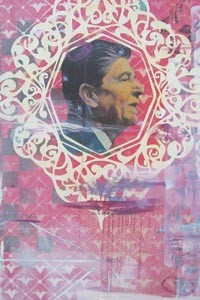In the aptly named exhibit History Remembered as an Image, at the Pittsburgh Center for the Arts, painter Matthew Friday taps into the traditions of centuries of European history painting and portraiture to revisit our recent political past and remind us that manipulation and hypocrisy are never far from our doorsteps.
Friday, a painting professor at Ohio University, knows well the language of his chosen idiom, and he employs his cues to strong effect. Four of the pieces are circular and symmetrical, reminiscent of coins or military insignias, and one of them explores the iconography surrounding Ronald Reagan. "The Great Communicator" boldly conjures the Reagan poise, this time in a movie still from the 40th president's younger days. A cowboy Ron is symmetrically reflected across the canvas, visually splitting the ruddy young stalwart into gun-slinging Siamese twins. Joining him in his warrior's yawp are helicopters, armed gangs on horseback, screaming eagles and, as if that weren't enough, Rambo himself, center-stage, at the base of the circle.
Out of a show of eight pieces, four are unequivocally Reagan-themed. For Friday, the Reagan Era and its eponymous commander-in-chief seem to represent a human recollection hopelessly detached from fact. The paintings' subject, an inveterate family man and the last great foe of the USSR, smiles and winks off the blowback of anti-democratic Central American coups like it's a distant heckler. The details become negligible. In the same way that, in the deftness of a Rubens painting, Marie de Medici becomes preternaturally glorious, Reagan got to be the hero because he looked like one and sounded like one.
The only larger non-Gipper piece is titled "The End of History," and it's probably the most decipherable image in the show. The group of characters in the foreground satirizes the strained inclusiveness that saturated ad culture in the '80s and '90s. Their faces feature varying traits of age, race and gender but, with the exception of a dour-looking Michigan-militia grandma, all are smiling brightly and looking in the same optimistic direction. On many of his canvases, Friday uses a stark white to apply the finishing strokes, and here he merges these marks with a white banner that spans the top of the picture plane and jubilantly proclaims "Another Victory."
Curious usage of the Quaker Oats mascot, and smoke clouds with the word "BANG," frame the sunny scene, though the most jarring appropriation is the humbly scaled but wholly visible terror-alert system. The all-too-familiar multicolored bars lend the piece, which is otherwise untethered to any particular period, an unsettling immediacy.
Friday's lexicon is potent, if not terribly subtle. He is, however, drawing on the methodology of European history painting and portraiture, which kept its own reserve of pictorial signifiers to illustrate bluntly the status of its subjects. Friday hijacks the mode of history painting to evaluate the limitations of both history and painting, thereby emphasizing the unavoidable distortion of the collective human memory that we call history, along with the further misconstruction of events that occurs when that history is depicted.
It is pointed that the artist, once his image is fully composed, blots it a bit with "translucent layers of antiquing glaze," according to his artist statement. More than those masters he draws from, Friday recognizes that the more one tries to impose clarity on history, the more the facts seem to slip out of line. Better, perhaps, to admit that we're all looking at a version of the story that has become, at the very least, fragmented and opaque.
History Remembered as an Image continues through Jan. 25. Pittsburgh Center for the Arts, 6300 Fifth Ave., Shadyside. 412-361-0873















